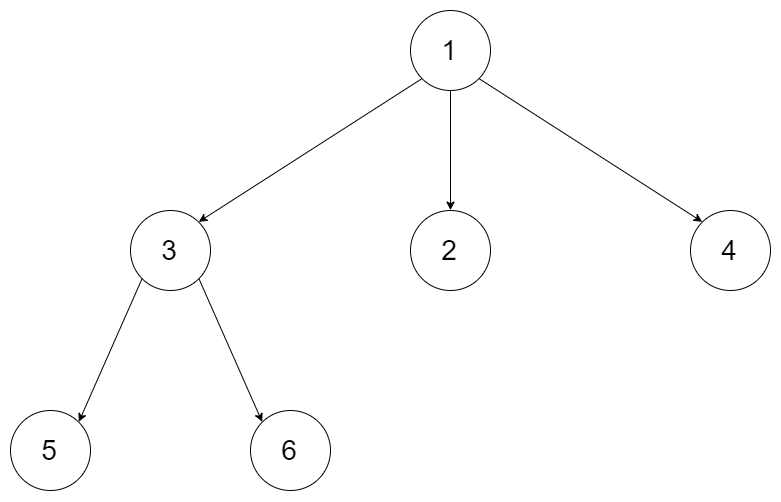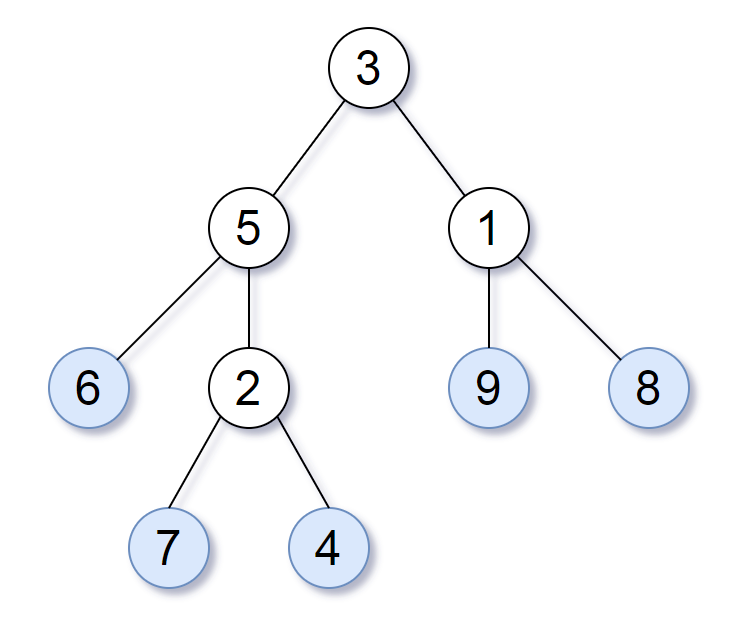LeetCode 690 559 872 員工的重要性 N叉樹的最大深度 葉子相似的樹 (DFS)
1.員工的重要性
難度:簡單
給定一個儲存員工資訊的資料結構,它包含了員工唯一的id,重要度 和 直系下屬的id。
比如,員工1是員工2的領導,員工2是員工3的領導。他們相應的重要度為15, 10, 5。那麼員工1的資料結構是[1, 15, [2]],員工2的資料結構是[2, 10, [3]],員工3的資料結構是[3, 5, []]。注意雖然員工3也是員工1的一個下屬,但是由於並不是直系下屬,因此沒有體現在員工1的資料結構中。
現在輸入一個公司的所有員工資訊,以及單個員工id,返回這個員工和他所有下屬的重要度之和。
示例 1:
輸入: [[1, 5, [2, 3]], [2, 3, []], [3, 3, []]], 1
輸出: 11
解釋:
員工1自身的重要度是5,他有兩個直系下屬2和3,而且2和3的重要度均為3。因此員工1的總重要度是 5 + 3 + 3 = 11。
注意:
一個員工最多有一個直系領導,但是可以有多個直系下屬
員工數量不超過2000。
思路:很明顯,該題用深度優先搜尋可以解決,即員工的重要性取決於他本身和下屬員工的重要性,那麼只需要知道下屬員工的重要度即可,利用遞迴很容易求解。
/* // Employee info class Employee { public: // It's the unique ID of each node. // unique id of this employee int id; // the importance value of this employee int importance; // the id of direct subordinates vector<int> subordinates; }; */ class Solution { public: int getImportance(vector<Employee*> employees, int id) { int totalDegree=0; totalDegree=getImpDegree(employees,id,totalDegree); return totalDegree; } int getImpDegree(vector<Employee*> employees,int id,int &totalDegree){ Employee* targetEmployee; for(int j=0;j<employees.size();j++){ if(employees[j]->id==id){ //從容器中搜索對應id的Employee的陣列 targetEmployee=employees[j]; } } totalDegree+=targetEmployee->importance; if(targetEmployee->subordinates.size()==0) return targetEmployee->importance; //遞迴的邊界條件 for(int i=0;i<targetEmployee->subordinates.size();i++){ int impDegree=getImpDegree(employees,targetEmployee->subordinates[i],totalDegree); //依次得到下屬員工的重要度 } return totalDegree; } };
2. N叉樹的最大深度
難度:簡單
給定一個 N 叉樹,找到其最大深度。
最大深度是指從根節點到最遠葉子節點的最長路徑上的節點總數。
例如,給定一個 3叉樹 :

說明:
樹的深度不會超過 1000。
樹的節點總不會超過 5000。
思路:其實該題跟獲得二叉樹的最大深度類似,用遞迴實現深度優先搜尋,注意邊界條件。
/* // Definition for a Node. class Node { public: int val; vector<Node*> children; Node() {} Node(int _val, vector<Node*> _children) { val = _val; children = _children; } }; */ class Solution { public: int maxDepth(Node* root) { if(root==NULL) return 0; int maxDepth=getMaxDepth(root); return maxDepth; } int getMaxDepth(Node* root){ if(root->children.size()==0) {return 1;} int MaxDepth=0; for(int i=0;i<root->children.size();i++){ int tempDepth=getMaxDepth(root->children[i]); if(MaxDepth<tempDepth+1){ MaxDepth=tempDepth+1; } } return MaxDepth; } };
3. 葉子相似的樹
難度:簡單
請考慮一顆二叉樹上所有的葉子,這些葉子的值按從左到右的順序排列形成一個 葉值序列 。

舉個例子,如上圖所示,給定一顆葉值序列為 (6, 7, 4, 9, 8) 的樹。
如果有兩顆二叉樹的葉值序列是相同,那麼我們就認為它們是 葉相似 的。
如果給定的兩個頭結點分別為 root1 和 root2 的樹是葉相似的,則返回 true;否則返回 false 。
提示:
給定的兩顆樹可能會有 1 到 100 個結點。
思路:用倆個容器儲存倆顆樹中的葉子值,然後對比倆個容器是否相等即可,該題主要考深度優先搜尋和樹。
/**
* Definition for a binary tree node.
* struct TreeNode {
* int val;
* TreeNode *left;
* TreeNode *right;
* TreeNode(int x) : val(x), left(NULL), right(NULL) {}
* };
*/
class Solution {
public:
bool leafSimilar(TreeNode* root1, TreeNode* root2) {
vector<int> root1Leaf=getLeaf(root1);
vector<int> root2Leaf=getLeaf(root2);
return root1Leaf==root2Leaf;
}
vector<int> getLeaf(TreeNode* root){
vector<int> allLeaf;
stack<TreeNode*> stack;
while(root!=NULL || !stack.empty()){
while(root){
stack.push(root);
if(root->left==NULL && root->right==NULL){
allLeaf.push_back(root->val);
}
root=root->left;
}
if(!stack.empty()){
root=stack.top()->right;
stack.pop();
}
}
return allLeaf;
}
};
